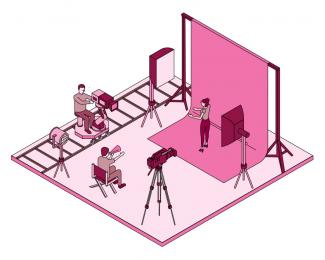
If sexual harassment were told to us
(This article was originally published in L'Edition No.18)
The historicisation of sexual harassment is the focus of the Avisa project which is opening a window on past written, pictorial, narrative and cinematographic representations of this social problem with the aim of stamping it out more effectively today.
On 5 October 2017, an upswell of complaints began in the American film industry. In several newspapers and across social media, nearly one hundred women, including several renowned actors, reported the violence and sexual assaults they had suffered at the hands of Hollywood producer, Harvey Weinstein. The MeToo movement, which was started in 2007 by the African American social worker and activist Tarana Burke in order to expose sexual and gender-based violence against minority women, gathered pace in the following months. Women in several countries started to organise themselves and march to demand more punishment for abusers and to stop sexual violence, including sexual harassment. A tidal wave of #MeToo inundated social media networks and in France denouncements were made using the hashtag #BalanceTon- Porc. It was an historical moment. It liberated victims’ voices across all sectors of business. “Although sexual harassment became more visible after the #MeToo movement, it’s nothing new – even though this offence has only become part of law relatively recently,” points out Armel Dubois-Nayt, a specialist in British Civilisation and the History of Ideas at the Heritage and Cultural Dynamics Laboratory (DYPAC – Univ. Paris-Saclay, UVSQ) and co-leader of the ‘Avisa – Historicising Sexual Harassment’ project.
However, the world seemed to be finally becoming aware of the extent of this scourge plaguing our societies. In October 2019, an IFOP (French Institute for Public Opinion) survey for the Jean-Jaurès Foundation and the Foundation for European Progressive Studies conducted in April 2019 using a sample of over 5,000 women from 5 countries in the European Union (Germany, Spain, France, Italy and the United Kingdom) representative of the female population aged 18 and over, revealed that 60% of the European women asked had already experienced some form of sexual harassment at work during their professional lives, and 21% of these had experienced it during the last twelve months. 65% of women had experienced at least one form of sexual assault or abuse on the street. This figure rose to 86% for French women. As a result, sexual harassment was shown to be a ubiquitous social fact and any strategy to combat it would involve going back to the origins of the problem. However, the history of sexual harassment still remains relatively unknown.
Historicising sexual harassment: a long-term project
The Avisa project started in 2020 thanks to Émergence funding from MSH Paris-Saclay. The project aims to bring to light other periods in the past when women and men have been subjected to acts of sexual harassment which they have sometimes denounced or fought legally or symbolically. The goal is to demonstrate that sexual harassment was reported long before the Weinstein affair, that it was condemned without necessarily being tried in court and that cases of sexual harassment are well documented.
The project, which takes its name from an English narrative poem dating from 1594 where the main female character successively repels the violent assaults of several suitors, brings together some thirty individuals from around fifteen European universities. Linguists, civilisationists, historians, film and audiovisual sociologists, specialists in literature, the history of ideas, arts and artistic practices, etc. are working together to shed light on the history of written, pictorial, narrative or cinematographic representations of sexual harassment in the West, from the Middle Ages to the present day. “The challenge is working with an interdisciplinary approach and getting people with different skills to interact on this subject,” points out Réjane Vallée, a film sociologist from the Pierre Naville Centre (CPN – Univ. Paris-Saclay, Univ. d’Évry), and co-leader of the Avisa project.
The valuable results from this collective research project are being fed into a bilingual digital platform which will eventually record the way in which these abuses have been reported and denounced. This platform will also contain a list of victims, whether they are historical, real or fictional people. “It will show their names, the evidence of the harassment and the source in which it was found,” explains Armel Dubois-Nayt. In conclusion, a real socio-historical map of where sexual harassment has taken place should emerge. “By mapping our findings, we want to see if geographical areas or time periods emerge where the problem has been particularly acute.” The project is only focusing on female victims for the moment. “We wanted to start with one type of harassment first, before looking into others,” explains Réjane Vallée.
The pandemic has meant that, up until now, Avisa has taken place remotely in the form of webinars. The first of the project’s conferences, entitled ‘Writing the History of Sexual Harassment over the Long Term: Naming, Denouncing, Representing, Putting into Images or into Music’ took place on 9 and 10 of December 2021. It was a chance for participants to agree on a common methodology for uncovering references to sexual violence in history and for tackling the texts, films and artworks which depict it. Some of the participants explained how this type of behaviour has been put into scenes and words in literary works or fiction (serials, films), or how it has been denounced, in order to better challenge it. Others had chosen to give a voice to women who have been victims of such acts and whose testimonies come from the worlds of dance, opera and film. These are all factors which will feed discussions for the rest of the project.
The same term but different definitions
To begin with, the team set out to clarify the definition of what we now call ‘sexual harassment’. “As the term is recent in usage, is it possible to use it to describe facts and events which took place in earlier periods? Wouldn’t that be anachronistic? Are there any other words which describe this type of behaviour?” asks Armel Dubois-Nayt.
Sexual harassment was defined in the French Penal Code, Article 222-33 of Law No.°92- 684 of 22 July 1992. Revised in 2018 by law No.°2018-703 to strengthen the fight against sexual and gender-based violence, the definition now refers to “repeatedly imposing on a person comments or behaviour with sexual or sexist connotations which either violate his or her dignity because of their degrading or humiliating nature, or create an intimidating, hostile or offensive situation.”
The English definition of sexual harassment does not imply repetition of the act. “Just once is enough,” points out Armel Dubois-Nayt. For UN Women, the UN body dedicated to gender equality and women’s empowerment, sexual harassment “refers to highly suggestive behaviour involving non-consensual physical contact, touching, pinching, rubbing with sexual connotations against another person’s body. It may also refer to behaviours which are not directly physical, such as whistling, sexual comments about a person’s body or appearance, requests for sexual favours, sustained looks and staring at any other person, following or watching them, or acts of exhibitionism.”
In view of this diverse range of definitions, the broad time scale and the diversity of geographical areas covered by the Avisa project, the team has decided to look at sexual harassment outside of any legal framework. “We decided to bring together the French, English and European definitions,” says Armel Dubois-Nayt.
The first indirect references
It is not easy to trace the first references to sexual harassment in history. “It can be said that at the very least the word ‘harassment’ was used in French in an idyl written by Jean Vauquelin de la Fresnaye which was published in 1605,” points out Armel Dubois-Nayt. “Chloé Tardivel, who is also involved in the project, has found references to sexual harassment in court cases in Bologna, Italy, at the end of the 14th century.” Did such cases result in complaints to the courts or convictions? “One of the precise aims of Avisa is to find out how such complaints reached the courts. However, it’s clear that until the beginning of the 20th century, this was always done indirectly. Legal action was taken for other reasons, and it was only in the course of the investigation that it became apparent that sexual harassment occurred. For example, if a man filed a complaint against a woman for slapping him and then later it became clear she did it because he was harassing her. It was only in the second half of the 20th century that women started filing complaints directly,” explains Armel Dubois- Nayt. “In addition, the class system remained very rigid until the 20th century, so stories of sexual harassment could only be found between people of the same class. Later, there were cases of servants lodging complaints against masters, something which would have been unthinkable under the Ancien Régime, especially if the master was an aristocrat.”
Some national or cultural particularities are also addressed within the Avisa project, including how sexual harassment is justified or explained. At the moment, the geographical area covered by the project is essentially European and includes France, Britain, Spain and Italy, as well as a few forays into the north of the United States because of Hollywood. “The focus is really on the West. However, we plan to extend our study into India in particular so that we can examine Bollywood cinema and its treatment of male-female relations,” points out Réjane Vallée.
After all, the history of sexual harassment and its manifestations is also a way of questioning relationships between the sexes, how this has changed and the status of women. Medieval painted ceilings, studied by historians Delphine Grenet and Maud Perez Simon, provide some good insights into this. These decorative features found in the grand homes of the urban elite during the 14th and 15th centuries depict scenes of a quite diverse nature. The so-called ‘courtly’ ones show men and women interacting. “Some of these scenes have strong sexual connotations and can clearly be seen as sexual harassment,” comments Armel Dubois-Nayt. The kisses, touching and forced, intrusive gestures depicted on the part of the men is questionable behaviour. “However, historical interpretations have still used the term ‘courtly’.” How then can we explain the presence of such a ceiling in the domestic interior of a stately home in the Middle Ages? Why are such scenes depicted and for whom were they intended? There are two possible interpretations. “They could have been a message intended for the young women and servants of the house that they needed to be careful around men and should remain virtuous. Or, they could have been aimed at the boys in the house in that they conveyed an image of masculinity where sexual harassment was cast in a favourable light,” suggests Armel Dubois- Nayt. Depending on which interpretation is preferred – a warning or a trivialisation of sexual violence – “This would mean that sexual harassment was part of the social interaction between the sexes at certain times.”
The problematic role played by the Arts
Literature, as well as art, also has an ambiguous relationship with sexual harassment. This can be seen in pastorals, which were a type of poem popular in the Middle Ages. “This literary tradition features a knight or a prince who tries to seduce a young peasant girl or a shepherdess – two characters portraying a hierarchical social relationship. The young woman refuses any advances or contact made by the man,” says Armel Dubois-Nayt. Is it all a pretence or is the refusal genuine? There are two opposing interpretations here too. The first argues that this is a literary convention in which the young woman’s rejection can only be a pretence in order to conform to the codes of honour at the time, according to which a woman couldn’t say ‘yes’ to a man’s advances, even if she liked him. The second supports a more current reading of the scene in that it should be reinterpreted as sexual harassment.
Other art forms are also not immune. “Generally speaking, artistic professions where the relationship with the body is important are affected by sexual harassment. The body, which is the working tool of women, is exposed to the gaze of men and this makes them particularly vulnerable,” explains Armel Dubois-Nayt. Dancers, for example, at the end of the 19th century and at the start of the 20th century were specific targets. “Based on women’s own accounts, Hélène Marquié (who is part of the Avisa project), has traced the dancers’ journey from the dressing room to the stage and shown the opportunities men took to touch and harass them,” says Armel Dubois-Nayt. They allowed themselves this liberty because, according to the mores of the era, the profession was associated with prostitution. “Dancers faced a lack of respect and so the fact that they were being harassed became less reprehensible. It became ‘almost’ part of the job.”
Other artists, such as opera singers, were also targets for sexual harassment, as Caroline Giron-Panel explains. “Here, too, women have been particularly harassed, both in the course of their work and in opera librettos, which repeatedly contained scenes of sexual harassment.” It must be remembered that the vast majority of 19th century operas had a love triangle as the plot, played out by a soprano, a tenor and a baritone. And, as the writer and music critic Georges Bernard Shaw pointed out, “Opera is about a soprano and a tenor who want to sleep together and a baritone who tries to prevent them from doing so.”
The rise of harassment on the street
Women’s work, which had so long been in the home, expanded in the 19th century into factories and industry. These were perfect examples of places where the genders mixed, and women came face to face with sexual harassment here. The historian, Anaïs Albert has analysed the archives of minutes from the Paris Labour Relations Court (Les Prudhommes de Paris) from 1850 to 1890 where she focused on the work of young female apprentices in the textile industry. “She found cases where parents filed a complaint in order to end their daughter’s apprenticeship contract because they felt that she was being sexually harassed,” says Armel Dubois-Nayt. Her study points to distinct situations of sexual harassment and acts of abusive language with sexual connotations. “These situations both arose from bosses who insulted their apprentices by using sexual language and from the environment in which the apprentices lived where employees talked about sex excessively.” The historian found cases of sexual harassment involving propositions, invitations, unwanted touching and intrusions by the boss into the apprentice’s bedroom, who was staying in his home. The Paris Labour Relations Court archives (and others) also revealed the harassment on the street suffered by these young apprentices and female milliners, clothing or hat designers. “They had to shop for their boss, so had to walk through the streets of Paris. They were preyed upon by ‘stalkers’ who followed them and harassed them,” points out Armel Dubois-Nayt.
With the arrival of cinematography in 1885, the character of the ‘stalker’ already present in the press and in books at the end of the 19th century, took on a new dimension. “The cinema drew its inspiration from this and used the same concept, i.e. a woman pursued by one or more ‘suitors’ in the streets as she walks along,” explains Réjane Vallée. However, this character has become slapstick and a source of comedy. The ‘stalker’ makes people laugh at his own expense. The audience finds the failure of his attempts funny, without feeling any empathy for the young woman harassed and victimised by the ‘stalker’.
The recent reappraisal of film
Was the world of cinema trivialising sexual harassment, or was it just reflecting an accepted banalization by many societies? “The poster for the French comedy ‘Promotion Canapé’, released in 1990, included the phrase ‘Sexual harassment exists, we’ve been there and done that’,” points out Réjane Vallée. Similarly, in the American comedy There’s Something About Mary, which was released in 1998, no one at the time was concerned about the sexual harassment of Mary by several men. “However, this type of thing has changed radically,” says Réjane Vallée. “It wouldn’t be conceivable to produce such films today. On the contrary, there are more and more films about trials and investigations into sexual harassment.”
As Olivier Caira shows, the treatment of female characters in films in the James Bond franchise illustrates this change. “To begin with, the posters showed a plethora of frequently naked young women. This has become less and less the case until, in the most recent ones, you don’t see women at all,” says Réjane Vallée. “And, depending on the social class of the female character (a hotel receptionist or scientist, for example), the sexual harassment displayed by James Bond was accepted in varying degrees by the viewer.” However, what was acceptable to viewers in the 1960s was not acceptable to viewers in 2010. “The question of sexual harassment and films is obviously a question of context and era.”
And the post-Weinstein era has also been affected. “Initially, we wanted to stop at this case, but we found that we had to go beyond it in some instances,” says Réjane Vallée. “For example, in the series Orange is the New Black, Jessica Jimeno perceived a change after this affair. The technical teams include more women and the last two seasons have a completely different approach in that the scripts now take revenge on the harasser.”
So that this important work can continue, MSH Paris-Saclay has recently granted the project new funding. Two workshops are already planned in 2022 – one in June and another in September. However, given the scope of the work, the whole team is looking far ahead. “We hope to create a snowball effect and encourage other researchers to become involved in this under-researched area,” says Armel Dubois- Nayt in conclusion.



